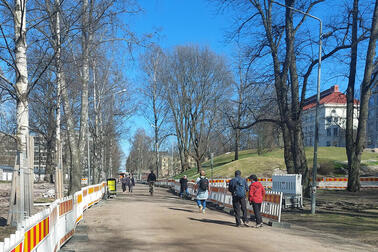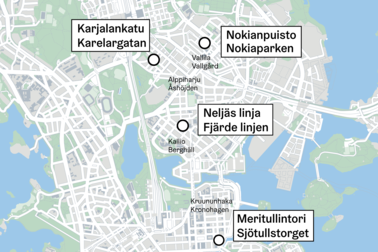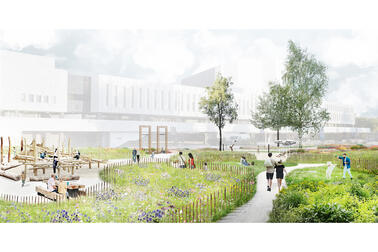
A call for tenders for new green wall solutions was arranged at the turn of the year. The aim was to find innovative solutions to create quieter and more comfortable green pockets in a dense urban environment, which could also provide benefits for biodiversity, microclimate regulation or rainwater management, for example.
Two green noise walls were chosen for testing. A green wall designed and realised by Wau Efekt serves as a green resting oasis in front of the Design Museum on Korkeavuorenkatu. The adjustable wall delineates the urban space and creates accessible outdoor spaces. At this site, the green wall is curved with shielded cubbyholes for seats inside the structure.
A modular green wall designed and realised by InnoGreen, Parkly and WSP Finland offers city residents a comfortable living area in Erottajanaukio. The wall has seating in the midst of diverse and abundant vegetation, and it protects against traffic noise coming from two directions. WSP will also carry out noise measurements at both sites to investigate and verify the impact of the green walls.
Green walls provide more comfortable urban spaces for city residents
The goal of the testing is to gather practical experience of multifunctional green solutions suitable for urban spaces to improve the acoustic environment. Meanwhile, technological solutions that can be combined with green walls are also being investigated. For example, the walls have sensors to measure temperature and humidity. In addition, the city will monitor the use of the walls and gather user experiences.
“We’re testing this type of noise barrier for a dense urban environment for the first time. In addition to noise control, it increases the volume of vegetation and provides a rest area under the shelter of a wall, and the structures can also be reused in the future,” says Jenni Kuja-Aro, Senior Environmental Specialist from the Urban Environment Division.
Helsinki as a testing platform for sustainable urban innovations
The whole of Helsinki serves as a development and testing platform for smart and sustainable business innovations. Realised in cooperation by Business Helsinki and the Urban Environment Division, the green wall testing is part of the city’s testing platform activities.
In the Testbed Helsinki platform, companies’ products and solutions are applied not only to the physical urban environment but also to the development of health, wellbeing, educational and digital services. Through the testing, the companies receive practical experience and feedback for the development of their products and business in an actual urban environment.
“The green wall testing is a good example of innovation activities that combine the sustainability perspective, benefits for companies’ product development and business operations, and the goal of improving the quality of the city residents’ living environment,” says Kimmo Heinonen, Head of the Innovation Services Team at Business Helsinki.
The green walls are available for all city residents to use until September.


